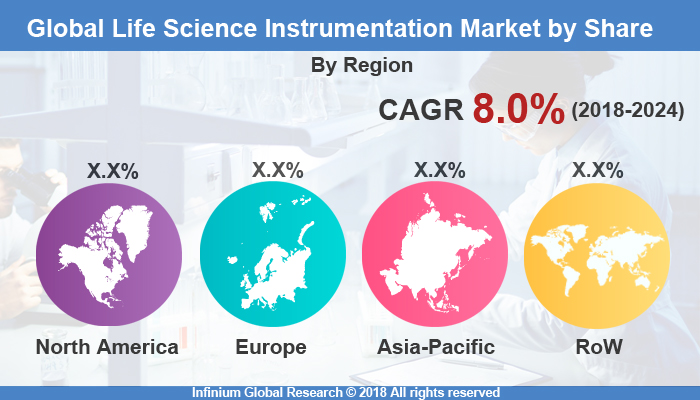Life Science Instrumentation Market: Global Industry Analysis, Trends, Market Size and Forecasts to 2024
A recent report published by Infinium Global Research on life science instrumentation market provides an in-depth analysis of segments and sub-segments in global as well as regional life science instrumentation market. The study also highlights the impact of drivers, restraints and macro indicators on the global and regional life science instrumentation market over the short term as well as long term. The report is a comprehensive presentation of trends, forecast and dollar values of global life science instrumentation market. According to the report the global life science instrumentation market is projected to grow at a CAGR of 8.0% over the forecast period of 2018-2024.
Market Insights
Life science instrumentation is used in industrial laboratories, biotechnology industry, pharmaceutical industries, and academic institutes for research & development activities. The advancement in technology and reductions in sequencing cost with the help of next generation sequencing (NGS) is driving the growth of the market. The demand for single cell analysis is growing as it offers more details on the genetic analysis, another factor that is likely to drive demand for instruments such as NGS tools and flow cytometers. The spectroscopy, chromatography, PCR, immunoassays, clinical chemistry analyzers, flow cytometry are the technology used in life science instrumentation.
The sequencing technology helps to understand the root cause of a disease thus increasing focus on NGS is likely to boost the growth of the market. Increasing government funding for R&D and favorable policies is another factor that propel the growth of this market. The technology advancement such as user-friendly and advanced bioinformatics tools will drive the demand for life science instrumentation market. On the other hand, high cost associated with the drug discovery process, shortage of funding in the emerging economies are likely to restraint the growth of the market. Additionally, a saturation of research instruments in the diagnostics application is likely to hamper the growth of the market.
Among the regions, North America is expected to be the largest market for life science technology owing to the increasing government support and investment for research in biotechnology. The presence of the leading companies in the life sciences is another factor that drives the growth in the North America region. The presence of the medical devices industry and the growing acceptance of innovations in the manufacturing sector in Europe will drive the demand for the life sciences instrumentation market in the region. The growth in Asia-Pacific is mainly driven by the presence of pharmaceutical and biotech companies in emerging countries such as China and India. For instance, BD biosciences have financed localized R&D facilities in China.
Segment Covered
The report on global life science instrumentation market covers segments such as technique and end user. On the basis of technique, the global life science instrumentation market is categorized into spectroscopy, chromatography, PCR, immunoassays, clinical chemistry analyzers, flow cytometry, and others. On the basis of end user the global life science, instrumentation market is categorized into pharmaceutical and biotech companies, hospitals, diagnostic laboratories, and others.
Geographic Coverage
The report provides regional analysis covering geographies such as North America, Europe, Asia-Pacific, and Rest of the World. In this section, the key trends and market size for each geography are provided over the period of 2016-2024.

The countries covered in the North America region include the U.S., Canada, and Mexico; while Asia-Pacific includes China, Japan, India, South Korea, Malaysia, and among others. Moreover, Germany, U.K., France, Spain, and Rest of Europe are included in the European region. The U.S. drives the growth in the North America region as it is the largest market in the region. The Asia-Pacific region offers a substantial potential for the market growth owing to rapid growth in markets such as India and China. The APAC region is projected to experience growth at a CAGR of x.x% over the period of 2018-2024.
Companies Profiled:
The report provides profiles of the companies in the global life science instrumentation market such as Agilent Technologies Inc., Thermo Fisher Scientific Inc., Becton, Dickinson, and Company, Danaher Corporation, Bio-Rad Laboratories Inc., GE Healthcare, PerkinElmer Inc., Merck KGaA, Hitachi High-Technologies Corporation, and Others.
Report Highlights:
The report provides deep insights on demand forecasts, market trends, and micro and macro indicators. In addition, this report provides insights on the factors that are driving and restraining the global life science instrumentation market. Moreover, IGR-Growth matrix analysis given in the report brings an insight on the investment areas that existing or new market players can consider. The report provides insights into the market using analytical tools such as porter's five forces analysis and DRO analysis of life science instrumentation market. Moreover, the study highlights current market trends and provides forecast from 2018-2024. We also have highlighted future trends in the life science instrumentation market that will impact the demand during the forecast period. Moreover, the competitive analysis given in each regional market brings an insight on the market share of the leading players. This report will help manufacturers, suppliers and distributors of the life science instrumentation market to understand the present and future trends in this market and formulate their strategies accordingly.
